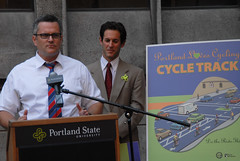
cycle track are why Portlanders drive
an average of 20% less than
people in other cities.
(Photos © J. Maus)
Yesterday, the City of Portland unveiled their first cycle track. At a press conference on the campus of Portland State University, Mayor Sam Adams was joined by PSU President Wim Weiwel and BTA leader Scott Bricker to sing each other’s — and the cycle track’s — praises.
The turnout at the press conference by the local media was amazing. I counted four TV station cameras and a bevy of local reporters. In Portland, re-configuring a downtown street to create space specifically for bicycle traffic is a big story (especially when that space was created by removing one lane previously used by motor vehicle traffic).
At the unveiling, Mayor Adams — who biked up the cycle track from his office — spoke about Portland’s success in providing options for people to get out of their cars. He said the cycle track is yet another response to “concerns” Portlanders have about bike safety. “It’s about protection and providing more comfort” Adams explained.
PSU’s Wiewel said cycle tracks are common in his home city of Amsterdam. He also focused on their safety benefits, saying “They’re probably the reason I’m still alive”.
Scott Bricker with the BTA said a survey they did in 2005 revealed that “people like to have a virtually carfree experience” and that the cycle track “makes that possible”. Bricker lauded Adams’ leadership and vision in making the project happened, but also added that he and the BTA will continue to push City Hall to build more of them.
The Mayor’s Office has just published a video of the press conference that includes more from each speaker (and a brief clip of yours truly):
Portland Unveils Downtown Cycle Track from Mayor Sam Adams on Vimeo.
But on the other end of the spin cycle are some local TV reports that seem to want to turn this into the latest front in the battle of “cars vs. bikes”. One report, by Anne Yeager on KGW-TV seemed to actually encourage negative feedback when she said on their 6:00 newscast: “If you love the idea, that’s great — but if you don’t, contact the mayor’s office.”
On other local media websites, the comments are flying in. The majority of them that I’ve read are negative. There are all the usual concerns that bikes are getting a free ride, that cars are being relegated to the margins, that the city is going insane, and so on.
The Oregonian’s coverage led to so many thoughtfully negative comments that reporter Joe Rose decided to post another story on his Hard Drive blog to stick up for the project. Rose dusted off the old “Green Dividend” study by Portland economist Joe Cortright (which shows that our region saves $2.6 billion annually because we drive fewer miles on average).
Even here on BikePortland, several commenters are staunchly opposed to the project.
To combat concerns and negative feedback, the City stresses that this is nothing more than an “experiment”. I wonder though, what would happen if they heard more negative than positive feedback on their experiment? Is the City losing the PR battle on this one?
And where is PBOT Director Sue Keil amidst all of this high-profile transportation news? Yes, Portland has a Director of Transportation, although you’d be forgiven for not knowing her name. You’d think that as Portland makes these major changes to its roadways that the top transportation staffer would play a larger role.
What is your sense of how the new cycle track is being received in Portland?



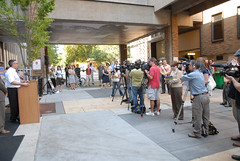
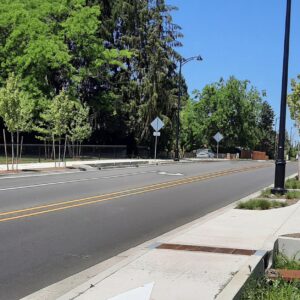
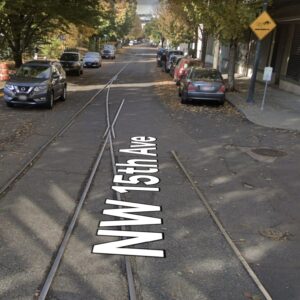
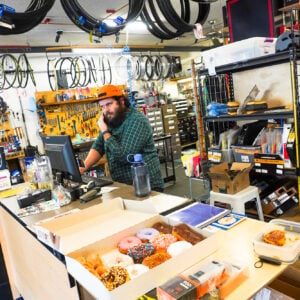
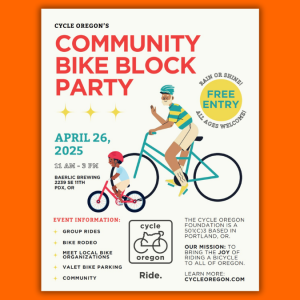
Thanks for reading.
BikePortland has served this community with independent community journalism since 2005. We rely on subscriptions from readers like you to survive. Your financial support is vital in keeping this valuable resource alive and well.
Please subscribe today to strengthen and expand our work.
Why should PDOT care whether people “like” the cycle track or not? If it makes SW Broadway a safer place for bicyclists, it stays. If it doesn’t, it goes.
I’m a little irritated with the idea that whether a car driver “likes” a bike lane or cycletrack is going to determine whether that lane exists or not.
And I thought Anne Yeager’s comment at the end of her story was ill-considered at best.
WTF? I really don’t get most of the negative feedback from motorists, since this project is explicitly designed for them, since it gets all those pesky cyclists off the road and out of their way…
Meghan,
I heard you and I agree to some extent. PBOT can’t do projects and make policies completely at the whim of the public… but PR will play a big role in Portland’s bike friendly future. Without PR on their side, the city will have a tougher time moving forward with the projects/policies they’ll need to reach their bike usage goals.. remember the Sauvie Island Bridge debacle?
Give your own feedback to the Mayor’s office and the other commissioners here.
People speak loudly when they’re angry, but tend to stay quiet when they’re happy. If you’re happy about this cycletrack and the other bike projects happening around town, push yourself to speak up.
I’ll give it more time but after riding it yesterday [as I will do every day heading out of town] I still wonder – Why?
To my mind, the whole scenario was functional and clean before and there are many other places in town that could be better served with tax dollars and improvement funding.
More later as everyone becomes more fluent in the new dialogue….
Some motorists should be reminded how they benefit from bike traffic.
It feels to me like this bike hating ranting is along the same lines as the town hall screamfests where people are demanding to see the presidents birth certificate.
Why is logic such a scarce commodity?
Jeff #5,
Because it was an easy way for the higher-ups to pat themselves on the back. Just thinking out loud here, but from the looks of the pictures, Mr. Mayor needs to bike more often.
I thought I was supposed to disengage and stomp off when angry? Now I’m confused.
The reaction is to be expected. For decades we have lived in a country where cars have been given supremacy. Driving has become a right, not a priviledge. Anything that is perceived as infringing on that right is considered a threat.
The media reaction is predictable too. How many automobile ads do you see on local news and in The Oregonian? How many ads for bikes? They also view this as a threat to their bottom line.
This isn’t going to change anytime soon. Even in the best cycling cities in the world there are still conflicts. The best we can do is get out there every day and use the facilities. It also doesn’t hurt to let the policy makers know what you do and don’t like about their investment choices.
It was pretty funny the two bikers I saw the news interviewing. One had earphones on and the other had no helmet.
The big issue is the taking of existing road space (that previously both experienced cyclists and motorists could use), and segregating that space at the expense of a full conventional traffic lane. Will motorists, still the majority of road users last I checked, feel they are getting the short end of the stick? Or will there be less car-bike conflict and smoother traffic flow as a result? Will more people ride because of this improvement in dedicated cycling infrastructure? Or will strong vehicular cyclists be irritated by the left turn boxes, and drivers expectations that they should use the cycle track? Only time will tell…
Good to see that this is being tested out. I am a little disappointed that the original conception of using the park blocks as the dedicated bike lane. Think of an arterial bike path extending from PSU all the way north to the Post Office. This would help to segregate the cyclists from the dangers of cars and be a great first step in promoting car-free coridors through the City.
OMG I sound a little crazy here.
Nice helmet, Sam.
Hopefully a decision to keep this, expand it, or kill it will be based on whether it attracts enough new cyclists to justify the expense to everyone, reduced lanes for drivers, and inconvenience for experienced cyclists. That was the justification after all. The cynic in me will be surprised if PBOT has a plan to find out how many new cyclists this does attract.
The PR war that should be waged is illustrated in the lead picture from the Bike Commute Challenge story below this one. By my reckoning 13 cyclists are waiting at the light taking up less than half the space of 5 or 6 cars in the adjacent lane. Would the people who complain about the space devoted to bike lanes rather have another 13 cars in front of theme at the light?
@ Michelle #4:
Thanks for the link. I just sent the Mayor a thank-you email:
“Just wanted to say I think the new cycle track is a great idea, and I’m looking forward to the upcoming changes on Oak and Stark.
I see from the Bicycle Master Plan that some bike boulevards are planned for outer SE (where I live). Can’t wait! I ride SE Bush on my daily commute to downtown. It’s on the list, and really only needs some signs and route markers since it’s already ‘traffic calmed.’
Thanks for all your hard work in making Portland a better place to live!”
I emailed Sam and told him it was awesome.
if anyone questions why elements like this in the city are so important and how they help drivers rather than hurt them i direct you to exhibit A as so eloquently put forward by my nyc friend as a reaction to her recent trip to portland:
http://fortheloveofbikes.blogspot.com/2009/08/portland-or-parking-space.html
Anne Yeager “If you love the idea, that’s great — but if you don’t, contact the mayor’s office.”
That’s like the signature line to those stupid thank a teacher-thank a soldier-thank god propaganda chain spam that was so ubiquitous circa 2003, which ended “if you disagree with this just delete it, if you agree please pass it to your friends and family.”
So our local news has been reduced to gimmicks employed by spammers. Well done KGW-TV.
Emailed Sam, told him thanks.
Inspired by Rixter’s performance on a KATU thread about the hit and run, I thought I’d jump into the fray commenting on KATU’s reporting on this. It’s really hard, logic isn’t always the best choice, but keeping it civil and having a sense of humor seem to help.
There’s so much wild misinformation out there… it’s a miracle anything gets done at all.
I thanked Sam via Twitter. 🙂
Motorist negativity is easily explained by the fact they just lost a lane of travel. I don’t care what PBOTs doctored numbers say, I live on that street, and it’s got HUGE motorist traffic. Plus the parking thing is awkward and un-vetted. Plus, now motorists will have to stop, for no other reason, to look for cyclists exiting this thing crossing intersections.
What about that wouldn’t make you mad as both a tax-payer, and a motorist? The experiment thing is getting worked way too hard. They removed a lane of travel, removed a fresh bike-lane that was inherently functioning normally, retreated 100 year old transportation paradigms, all for what?
To make cycling more attractive? What’s the number here? Nobody has a clue right? That could be a number between zero and several thousand, right? But the tens of thousands of people who just lost on this don’t have a justified gripe?
Right.
And what of you speaking to motorist entitlement? What is this thing if it ain’t entitlement?
This is going to turn SW Broadway into a parking lot at peak, everyday. I guess you guys like sucking car fumes.
Isn’t it time our Mayor got himself a proper Omafiets? I’d bet the guys at Clever would set him up with a nice VIP discount. I think it’s a little bit embarrassing. The President doesn’t fly a DC-9, our Mayor shouldn’t ride a 26″, flat barred mountain bike.
I’ve emailed Mayor Adams and the City Council thanking them for the cycletrack as well as the buffered bike lanes on SE Holgate. Also thanked Mayor Adams in a tweet.
These are exciting times for Portland, gotta keep the positive feedback going strong!
I’m really excited about the cycle-track and look forward to trying it out soon both by bike and by car.
I’m really curious to see how well the new parking position is understood by citizens in cars as well as how comfortable the left-turn feels.
On one-way streets I feel pretty comfortable about crossing over to use the left lane to turn, but I can definitely see how this would make me more confident about my safety while turning left.
And when it comes to parallel parking a car, how will it feel to swing the tail of a car into the spot without straying into the buffer and bike zones. Really curious. Awesome experiment!
@ Ron #11 – let’s see, 43′ for motor vehicles, 7′ for cyclists; despite my objections to this facility for other reasons already stated in other threads here, from from a purely mathematical perspective, that seems pretty fair to me. and when cycling exceeds 15% of the transportation mode split we can take some more of the motorist’s space away.
😉
I guess I understand that they want to test the cycletrack idea on a small strip of the city with a lot of bicylists (its right at PSU, and goes straight to the center of campus where all the bike parking is) there’s a low-traffic street RIGHT next door (park, heading both north and south). I mean, why spend 80,000 dollars to build a bike lane right next to a park? It doesn’t really make sense to me. It’s a good idea I guess, especially in the dangerous areas. I mean, on that section of broadway you cannot turn right or anything, so I can’t see how a normal bike lane wouldn’t be safe. Except that it’s nice to have the buffer zone so people don’t get doored
Motor vehicles are a viable means for 60% of travel & shipping.
Sad that most the complainers are simply lazy folks in the remaining 40% that would rather jump in the car and spend 6.00 in gas to buy a 2.00 burger at Micky D’s.
Stupid to think the answer for congestion is just build more roads all the time.
Especially when on a bike I can blow the doors off any car downtown.
Now if mass transit would stop gouging the public might be a start.
Hey city “leaders”, lead with your brains, not with public opinion.
I have noticed lately (health care, green reform) that the sampling of public opinion on everything from stimulus funding to the CRC is being encumbered by the noise coming from the far right. Unfortunately, they do not pose as such and mislead politicians into thinking THEY represent majority sentiment. In other words, the squeaky wheel gets the grease.
Here again (re: cycletrack) i am reminded of the dire consequences of rule by the masses. If our leaders never speak up and support what might, in the short term, be unpopular but long term solutions to real problems, we will never see positive reform, Only more of the same.
Stand tall Mayor, PBoT and affiliates, LEAD not FOLLOW! A cycletrack for every major thoroughfare in the next 10 years!
Burr #26: I see your point, but you could also argue that the bike share has not changed from before (100% access), and the car share has gone down from three lanes to two. (A 33% reduction.) I hope and believe Vance’s dire predictions are significantly overstated, but I also understand his concern. If we want good relations between cyclists and motorists, we each need to consider the realistic needs of the other.
This silly idea is doing exactly what I thought it would. Provoke backlash for a really marginal improvement for cycling, if any. It was a stupid idea in an area that didn’t need it and it will just make it that much harder to get anything else done. However, if this kind of idea is what people here think we should do, maybe having the next “great idea” get shot down is for the better. This “lane” will be full of garbage in about a week that nobody will want to ride on. “Dooring” will happen more frequently because people getting out of cars on that side will pay no attention. Nice going!
The switch looks great for both cars and bicycles right now. Wait till PSU starts Fall Term classes and it will be a parking lot, with the decrease in lane for vehicles, all the way down Broadway to Pioneer Square. Especially, during the 5:00pm rush hour. Cyclists will be happy though, until the frustrated drivers take out their anger on them. =(
Hey Vance, have you ridden it yet? It’s quite easy to exit with the “Copenhage left” boxes and the only right turn for cars happens with plenty of clear space (no parked cars) where cyclists and motorist are in plain view of each other. It’s actually much easier to pass all the waiting cars now in my opinion, and lots more USABLE bike passing room without being sandwiched between gridlock and parked cars.
One short cycletrack my not increase ridership, but a blanket of these along appropriate routes with traffic calming definitely would.
My 2 cents 🙂
While the illusion of safety may appeal to novice riders, being aware of the fact that you are sharing the road with cars will keep you alive longer. What happens when PSU students come back? Does anyone think that they won’t be crossing the cycle track and parked car stip to wait to jaywalk? In the past, they would come out to the bike lane to look for cars but seldom stood in the bike lane. Now jaywalkers crossing from the left will be able to dart in front of cyclists from between parked cars. Cyclists trying to make lane changes to the left is also going to be fun. I guess the option to occupy a car lane to get around buses, delivery trucks, and cars dropping off passengers is gone now, too. I think cycle tracks rank up there with bike boxes as solutions in search of problems. By the way, I love the new Max tracks, too. Cycling past PSU has never been better!
Sorry kitty but the public opinion of which you speak is not coming from the right, polls show it is coming from moderates. The same people who had no allegiance to either right or left and as such are not held in lock step by some party mindset. These are the people that politicians go after with their promises, they know they’ve got the die hard votes.
And as such these same people look at promises made and promises kept, or not, and will actually change their minds about supporting a specific person or policy.
Much the same way people here look at these issues as cars vs bikes all the time, not every “pro” cycling initiative is a good thing. Zealotry is just as bad as apathy.
I think a lot of these changes are not warmly received at first, and then people gradually get used to them. Occasionally, the same haters may start bragging about these assets to their friends.
“Only in Portland..”
My understanding is most of the bike boulevards were cause for consternation in their early implementation, but now people see that it raises property value, makes their neighborhoods more livable, beautiful and safe.
We don’t like change, until we get used to it.
I feel that the same ‘cars are being marginalized’ logic comes from the same place that spawns ‘white men with money are being oppressed’ idea.
I have spent the last couple months riding cycle tracks in Holland, Sweden and Denmark. I am still in awe by their ubiquity across the Netherlands; there are few streets or roads without them and they are clearly viewed by engineers and planners as integral parts of the public right-of-ways.
And because cycle tracks still mingle cyclists with cars at every intersection, motorists must still be mindful of cyclists in the roadway. So the separation of bikes and cars is not complete and it appears you retain some of the key benefits of shared lanes (i.e. more cautious drivers and safer streets for everyone)while still providing safe routes for even the most vulnerable or inexperienced cyclist. It does seem that cycle tracks are a needed addition too Portland’s mixed system of bike lanes, bike blvds, and multi-use paths.
Jim
i heard that years ago when california had to compromise between drivers wanting cyclists off the road and needed to leave a little room for cyclists, the state invented the bike lane. bike lanes have turned out to be enough of an issue through the years. what i want to know is who got their way with the cycle track? that thing’s stupid.
I find it hard to believe this was even slightly controversial. There’s parking, there’s a bike lane, they just swapped places. I love it! I hope they’ll carry this concept all the way back down Broadway.
It will take folks some getting used to, but I believe we’ll all make it. Here are two interesting examples from my ride through there this afternoon.
There was the lady driving in the bike lane behind me honking at me as I lingered before the light on Harrison. Apparently she wanted me to get out of the way so she could park where I was riding. After she parked in the bike lane between the parked car on her left and the curb, I tried to tell her she was in the bike lane. She was not having any of it! Right on, I thought I’d just let the bikes flowing past her make the point. Sure enough, she moved along before too long.
Then there was the guy in the SUV who dropped someone off and then executed a perfect Copenhagen left using the bike box. Nice job! Maybe the drivers understand that left hand turn box better than most cyclists 😉
I ask myself “why”? Can this be anything but a marginal improvement for cycling? I find bike lanes to work very well. But I will make a special trip to ride it…and keep an open mind
If you feel entirely safe riding around Portland today, you don’t need cycle tracks. You constitute something less than 5% of the total population.
If you are in that 95% you are likely to appreciate the near-elimination of potential motor vehicle/bike conflicts the cycle track provides. (And it’s highly unlikely that you’re reading this. So it would serve us well to consider the source when reflecting on blog comments.)
Now put yourself in the shoes of the decision-maker. The litany of policy reasons for why a decision-maker would want to encourage bicycling is longer than that PSU cycle track in 12 point font. 5% of the population says existing conditions are perfect, mostly in the form of rants on blogs opposing change. 95% of the population speaks with its actions. Which way do you go?
Exactly. Expect to see more cycle track in Portland. For the good of the many.
Andre #37 +1 well said
Jim Labbe’s comments got me curious. Is there anybody out there that has ridden a bike in the Netherlands that thinks Portland’s bike infrastructure is better than theirs? I’ve never even heard of such a person.
There must a VC that has. Maybe he’ll present his argument here for our benefit. Relatedly, are there any female VCs? The VC perspective is so inherently macho, I’m curious about that too.
It seems to me there are two kinds of perspective in this argument. Those that have experience riding in conditions with cycle tracks and those that do not.
Meghan H’s comment #1; If the new cycle track on Broadway makes the road a safer place for people riding bikes(it should easily do that)…that’s good…but the road, of which the cycle track is part of, has more to do than make the road safer for bikes. It’s also got to help move a lot of vehicles through town.
If this new road layout with cycletrack can do that without substantially backing up traffic more than it did before being reduced from 3 main travel lanes to 2…then great. I think the on-street parking is probably a bigger potential cause for traffic hold-ups that might occur than is the removal of one of the 3 lanes of travel. Since on-street parking is one of the city’s ‘cash cows’… .
All we have to do is let a little time pass to see how this thing pans out. Hope it does. If nothing’s tried, nothing’s learned.
if our political leaders cared more about people and less about press conferences, we would have real progress. but, by all means, enjoy the 6 blocks of safe riding.
I am hopeful that there is plenty of support for meaningful projects on the city council. more action, less photo ops, please.
A cycle track is grade-separated and has physical barriers to prevent cars from intruding – that’s what makes is a cycle track. the cycle track in the video does not have any barriers and it does not look like it’s grade-separated. Portland needs to build a real cycle track before they start throwing around the term so loosely.
Anyway the point of real cycle tracks is that they attract the other 98% of the population that doesn’t want to share the road with cars when they ride a bike. that’s tapping into a huge potential market. you can get upwards 30% of the population biking this way. The cycle tracks will be supported by the people who use them. The support for cycle tracks comes afterwards, not before. Although it would help if they would build an actual real cycle track with physical barriers and grade separation and separate signals, etc. the real deal. you get what you pay for.
It’s a good first step. Will encourage many who would not ordinarily do so to get on a bike. Some posters here with experience riding in traffic don’t see the point, but you have to consider the perspective of a novice biker.
So many people at work give me grief for riding my bike. But ultimately many admit they would like too as well, but they perceive it as being too dangerous. The population that a comprehensive network of cycle tracks could attract is HUGE. Makes me proud to live in Portland.
I think as people who are interested in getting more people out of cars and onto bikes, it is important that we show appreciation to the city for trying things like this, even if we aren’t thrilled about the specific implementation or whatever – as you can see from the reaction, this isn’t an easy move for them, and I think giving them the encouragement that people appreciate them trying things will help them try more things in the future.
Really, even if you have some issues with a specific project, along with your concerns, let them know you appreciate that they are willing to try things to better the traffic situation, or we may end up with them just giving up and relegating space to more freeways through the city. Seriously, I think it’s in all of our best interest to encourage them to try automobile traffic reduction measures.
http://CrankMyChain.tv is going run a live feed from the cycle track this afternoon at noon so you can check it out virtually. If you are going the farmers market or the university come down and say hello.
We are going to ride it a few times, interview some users (perhaps some motorists), play a few songs, and show some videos.